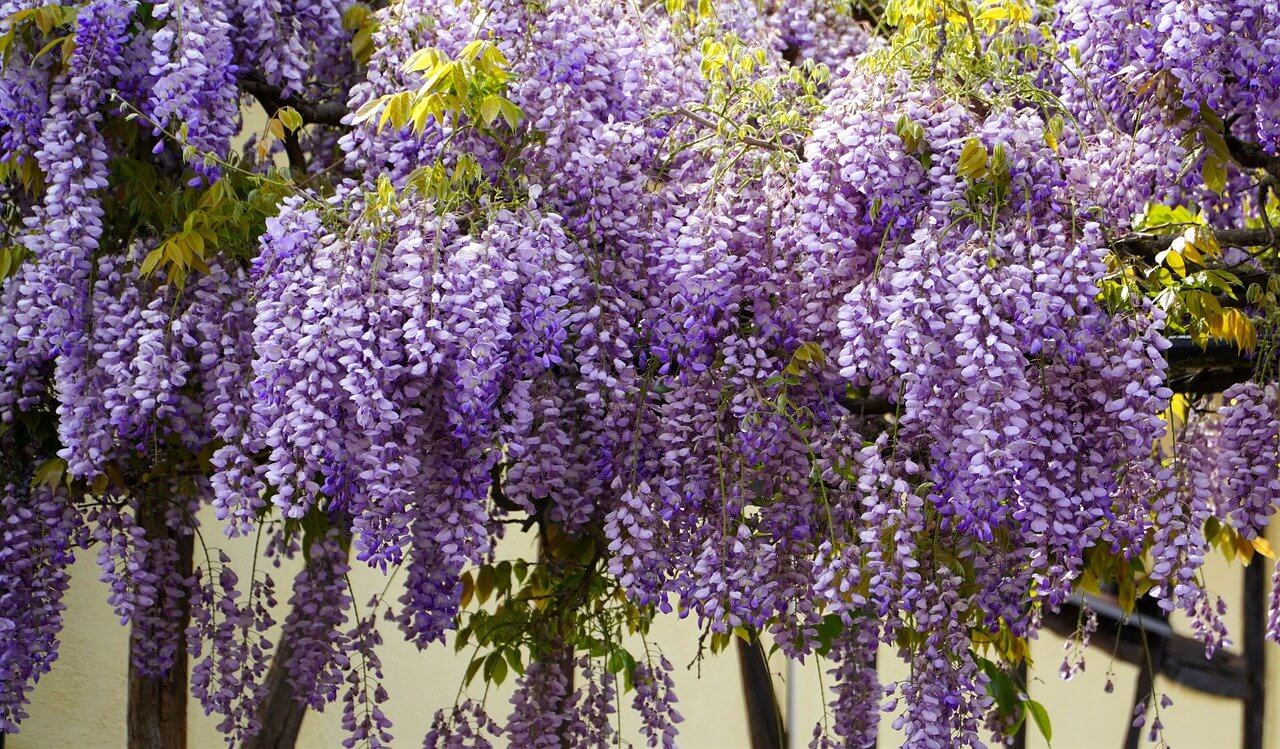Wisteria vines produce brilliant cascading vines that can climb almost anything you allow them to. A pergola, trellis, or wire frame are all good candidates. But not everyone has the space or the perfect structure for them to grow on. In this article, we’ll discuss how you can train your wisteria to grow in tree form, and how to care for it.
What You'll Learn Today
Can You Train a Wisteria Vine Into a Tree?

Many seasoned gardeners warn beginners to stay away from wisteria, and with good cause. This is not a plant that can be put in the ground and then neglected.
When left to its own devices, wisteria gets out of control quickly. It’s an aggressive climber that will attach to any structure it can reach.
Wisteria can get quite heavy after a while and can damage the structure it climbs. It’s also been known to grow through windows and onto pipes, so experts warn against growing it too close to your house.
Thankfully, if you love the beauty of wisteria but don’t want it climbing any structures on your property, you can still enjoy it. Wisteria can be trained into a tree if you start when the vine is young.
How Do You Train Wisteria To Be a Tree?

Training a wisteria vine into a tree might sound intimidating, but it’s probably simpler than you would think. Here’s how to do it:
Step 1: Plant Your Wisteria
To plant your vine, dig a hole that’s at least twice as wide as the root ball, and the same depth. Set the plant in the hole so that the top of the root ball is at soil level, and then fill the hole with dirt.
Step 2: Place a Wooden Post in the Ground
Your post should be a wooden 4×4 that’s at least a foot taller than the height you want your tree to reach.
Use a mallet to drive the post into the ground. Make sure the post is driven at least 12 inches underground. It should also be about 3 inches away from the base of the wisteria plant, making sure to avoid the root ball.
Step 3: Prepare the Trunk
If there are multiple stems on your wisteria, designate the healthiest-looking stem to act as the single trunk of the tree. Then use pruning shears to cut back any side shoots that are growing off of that stem.
When you’re trimming the side shoots, take care not to cut into the main stem.
Step 4: Stake the Trunk
Line up the stem you chose vertically against the side of your wooden post.
Tie the stem to the post, spacing each tie around 8 inches apart. You can use tie tape, cloth ties, or improvise with any sort of soft material.
When you’re tying, make sure it’s tight enough to stabilize the vine, but not so tight that it doesn’t have room for natural movement or growth. As it grows, you may have to loosen some of the ties.
Step 5: Shape the Tree
As your wisteria grows, cut any side shoots that grow from the main stem (trunk).
Once the vine reaches about a foot higher than the top of the wooden post, cut the top of the main stem. The cut should be right above a growth bud since side shoots will emerge from the bud.
Soon, another bud will grow from the side shoots and start to form the canopy of your tree. Once the branches grow at least 6 leaves, cut the branch right above the 6th leaf. This will cause the tree to branch out further.
This YouTube video gives great examples of how wisteria looks when it’s being trained, and what it looks like once it’s fully mature:
How To Control Wisteria?
Performing regular pruning and maintenance will be integral to keeping your wisteria tree healthy and under control.
Wisteria trees, just like the vine form, need to be pruned twice per year. In late winter when the tree is still dormant, you’ll be preparing it for spring growth and flowering season.
With no leaves on the tree, it’s easy to see which branches are dead, crowding other branches, or growing out of form. Cutting these branches will ensure that the tree will put the energy it needs into making blooms, and that those blooms won’t be covered by unruly branches.
The second pruning should be done in summer, once all of the spring blooms fade. At this point, you can trim all of the side shoots in the canopy back to about 12 inches.
Those 2 pruning sessions are the bare minimum that needs to be done each year, but it’s best to do routine maintenance in between. Late summer, for example, is a good time to trim the new growth that emerged since you last pruned.
How Deep Are Wisteria Roots?
Wisteria roots don’t grow particularly deep, but they spread out aggressively. For this reason, you’ll need to pay close attention to where you plant it.
Wisteria should not be planted too close to a wall or pavement. The roots are strong and can grow into them, which can cause severe damage.
If you do plant your wisteria near a wall, you can place a corrugated plastic panel in the ground to force the roots to grow away from the structure.
Training your wisteria into a tree is a process that will take years to achieve the perfect form. But once your tree reaches the perfect height and starts to branch out, it’s so rewarding.
Keep in mind that your tree doesn’t have to be neat and tidy – these versatile vines can be trained to grow in many different forms.
I recently bought a small wisteria tree that is only 4” tall. Should I plant it in a small pot until it gets bigger? I live in Western Ny and our winters can be extreme so I’m wondering if I do put it in a small pot should I store it in the garage until spring?
Any info is appreciated!
Thank you,
Nancy
It is definitely a good idea to keep your young Wisteria in its pot until your extreme winter has passed. These are very hardy plants, but a young one like yours should be protected until it reaches maturity – planting it out in the Spring will give it a much better chance at surviving.